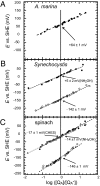Redox potentials of primary electron acceptor quinone molecule (QA)- and conserved energetics of photosystem II in cyanobacteria with chlorophyll a and chlorophyll d
- PMID: 21521792
- PMCID: PMC3093462
- DOI: 10.1073/pnas.1100173108
Redox potentials of primary electron acceptor quinone molecule (QA)- and conserved energetics of photosystem II in cyanobacteria with chlorophyll a and chlorophyll d
Abstract
In a previous study, we measured the redox potential of the primary electron acceptor pheophytin (Phe) a of photosystem (PS) II in the chlorophyll d-dominated cyanobacterium Acaryochloris marina and a chlorophyll a-containing cyanobacterium, Synechocystis. We obtained the midpoint redox potential (E(m)) values of -478 mV for A. marina and -536 mV for Synechocystis. In this study, we measured the redox potentials of the primary electron acceptor quinone molecule (Q(A)), i.e., E(m)(Q(A)/Q(A)(-)), of PS II and the energy difference between [P680·Phe a(-)·Q(A)] and [P680·Phe a·Q(A)(-)], i.e., ΔG(PhQ). The E(m)(Q(A)/Q(A)(-)) of A. marina was determined to be +64 mV without the Mn cluster and was estimated to be -66 to -86 mV with a Mn-depletion shift (130-150 mV), as observed with other organisms. The E(m)(Phe a/Phe a(-)) in Synechocystis was measured to be -525 mV with the Mn cluster, which is consistent with our previous report. The Mn-depleted downshift of the potential was measured to be approximately -77 mV in Synechocystis, and this value was applied to A. marina (-478 mV); the E(m)(Phe a/Phe a(-)) was estimated to be approximately -401 mV. These values gave rise to a ΔG(PhQ) of -325 mV for A. marina and -383 mV for Synechocystis. In the two cyanobacteria, the energetics in PS II were conserved, even though the potentials of Q(A)(-) and Phe a(-) were relatively shifted depending on the special pair, indicating a common strategy for electron transfer in oxygenic photosynthetic organisms.
Conflict of interest statement
The authors declare no conflict of interest.
Figures



Similar articles
-
Redox potential of pheophytin a in photosystem II of two cyanobacteria having the different special pair chlorophylls.Proc Natl Acad Sci U S A. 2010 Feb 23;107(8):3924-9. doi: 10.1073/pnas.0913460107. Epub 2010 Feb 8. Proc Natl Acad Sci U S A. 2010. PMID: 20142495 Free PMC article.
-
Modified molecular interactions of the pheophytin and plastoquinone electron acceptors in photosystem II of chlorophyll D-containing Acaryochloris marina as revealed by FTIR spectroscopy.Photosynth Res. 2015 Aug;125(1-2):105-14. doi: 10.1007/s11120-014-0073-x. Epub 2015 Jan 6. Photosynth Res. 2015. PMID: 25560630
-
The nature of the photosystem II reaction centre in the chlorophyll d-containing prokaryote, Acaryochloris marina.Photochem Photobiol Sci. 2005 Dec;4(12):1060-4. doi: 10.1039/b507057k. Epub 2005 Nov 7. Photochem Photobiol Sci. 2005. PMID: 16307123
-
Constitution and energetics of photosystem I and photosystem II in the chlorophyll d-dominated cyanobacterium Acaryochloris marina.J Photochem Photobiol B. 2011 Jul-Aug;104(1-2):333-40. doi: 10.1016/j.jphotobiol.2011.02.017. Epub 2011 Feb 23. J Photochem Photobiol B. 2011. PMID: 21530298 Review.
-
Unique photosystems in Acaryochloris marina.Photosynth Res. 2008 Oct-Dec;98(1-3):141-9. doi: 10.1007/s11120-008-9383-1. Epub 2008 Nov 5. Photosynth Res. 2008. PMID: 18985431 Review.
Cited by
-
Hydroxyectoine protects Mn-depleted photosystem II against photoinhibition acting as a source of electrons.Photosynth Res. 2019 Aug;141(2):165-179. doi: 10.1007/s11120-019-00617-w. Epub 2019 Jan 30. Photosynth Res. 2019. PMID: 30701483
-
Biofilm growth and near-infrared radiation-driven photosynthesis of the chlorophyll d-containing cyanobacterium Acaryochloris marina.Appl Environ Microbiol. 2012 Jun;78(11):3896-904. doi: 10.1128/AEM.00397-12. Epub 2012 Mar 30. Appl Environ Microbiol. 2012. PMID: 22467501 Free PMC article.
-
Electron transport in Tradescantia leaves acclimated to high and low light: thermoluminescence, PAM-fluorometry, and EPR studies.Photosynth Res. 2020 Dec;146(1-3):123-141. doi: 10.1007/s11120-020-00767-2. Epub 2020 Jun 27. Photosynth Res. 2020. PMID: 32594291
-
Impact of energy limitations on function and resilience in long-wavelength Photosystem II.Elife. 2022 Jul 19;11:e79890. doi: 10.7554/eLife.79890. Elife. 2022. PMID: 35852834 Free PMC article.
-
Structure/function/dynamics of photosystem II plastoquinone binding sites.Curr Protein Pept Sci. 2014;15(4):285-95. doi: 10.2174/1389203715666140327104802. Curr Protein Pept Sci. 2014. PMID: 24678671 Free PMC article. Review.
References
-
- Mimuro M, et al. Identification of the primary electron donor in PS II of the Chl d-dominated cyanobacterium Acaryochloris marina. FEBS Lett. 2004;556:95–98. - PubMed
-
- Miyashita H, et al. Chlorophyll d as a major pigment. Nature. 1996;383:402.
-
- Murakami A, Miyashita H, Iseki M, Adachi K, Mimuro M. Chlorophyll d in an epiphytic cyanobacterium of red algae. Science. 2004;303:1633. - PubMed
Publication types
MeSH terms
Substances
LinkOut - more resources
Full Text Sources
Molecular Biology Databases

